Land Economic Efficiency and Improvement of Environmental Pollution in the Process of Sustainable Urbanization: Case of Eastern China
Abstract
:1. Introduction
2. Materials and Methods
2.1. Study Area
2.2. Methods
2.2.1. Entropy Method
2.2.2. Map Visualization of Data
2.2.3. Econometric Model
2.3. Research Idea
3. Variable Design and Analysis
3.1. Explained Variable
3.2. Explanatory Variables
3.2.1. Core Explanatory Variable
- (1)
- Economic growth. Economic growth is the basis of economic development. This study uses GDP growth rate and industrial production intensity (gross industrial output value above scale/land area) to measure it. GDP growth rate visually reflects the growth rate of the region’s production capacity. The gross industrial output value above scale reflects the level of industrial production in the region, and when divided by its urban area, the industrial production intensity obtained excludes the effect caused by the size of the city.
- (2)
- Economic structure. Economic structure includes industrial structure, population structure, etc. A reasonable economic structure is conducive to economic development. In this study, we use the share of tertiary output (tertiary industry output value/GDP), tertiary industry production intensity (tertiary industry output value/land area) and employment density (urban employment population/land area) to measure it. Tertiary industrial output reflects the development of the service sector in the region. The development of sustainable cities leads to changes in urban functions [55], most notably a decline in the share of secondary industrial output and an increase in the share of tertiary industrial output over the years [56,57]. Dividing tertiary industrial output by GDP and land area, respectively, controls for the impact of the size of the economy and the size of the city on it. Labor is a necessary element of production, and a city without employed people will struggle to support economic development. In this study, we divide urban employment by land area to exclude the effect of city size.
- (3)
- Economic quality. Economic quality is not only reflected in the current economic development achievements, but also in the potential for economic development of the region. This study uses GDP per capita, R&D intensity (science and technology expenditure in the general public budget/land area) and road density (urban road area/land area) to measure this. GDP per capita visually reflects the average production capacity and indirectly shows the income level of the residents, and can better measure the current economic development achievements of the region. Innovation is the first driving force of development and a key factor in escaping the middle-income trap. On the one hand, science and technology expenditure reflects the importance the government attaches to innovation development and judges whether the government’s economic development course is reasonable [58]. On the other hand, science and technology expenditure promotes innovative development and has long-term significance in optimizing production methods, increasing production efficiency and improving product competition [59]. Urban road density is a direct reflection of the accessibility of a city. Convenient transport is an important component of economic development and can reduce commuting times and improve the quality of life of residents.
3.2.2. Control Variables
3.3. Data Resource and Processing
3.4. Analysis of Spatio-Temporal Evolution of Key Variables
3.4.1. Carbon Emissions
3.4.2. Land Economic Efficiency
3.4.3. Comprehensive Discussion
4. Empirical Design and Results
4.1. Model Design
4.2. Regression Results
4.3. Further Analysis
5. Discussion
5.1. Discussions of Spatio-Temporal Evolution
5.1.1. Carbon Emissions
5.1.2. Land Economic Efficiency
5.2. Discussion of the Empirical Results
6. Conclusions
- (1)
- From 2011–2017, carbon emissions in eastern China were generally more spatially distributed along the coast than inland, and more to the north than to the south, and this pattern did not change over time. Only Beijing achieved a significant downgrade in carbon emissions in 2017 due to its special strategy (“factory relocation” and “coal-to-gas”) [68,69].
- (2)
- From 2011–2017, the land economic efficiency in eastern China was generally characterized by higher coastal than inland efficiency, but there is no significant difference between the north and the south. At the same time, according to the number of high-, medium- and low-efficiency areas in the three time points (2011, 2014 and 2017), the land economic efficiency in eastern China has been changing towards “medium efficiency” over time. This suggests that the differences between regions are narrowing and that most regions were upgraded from “low efficiency” to “medium efficiency”.
- (3)
- From Table 3, eastern China as a whole is still unable to achieve synergistic development of land economic efficiency and the environment. However, the further findings of Table 4 demonstrate that the 18 most economically developed cities in eastern China (Section 4.3 for a list of these cities) have been able to achieve synergistic development of land economic efficiency and the environment. Furthermore, according to this study, there are four important factors that contribute to the low land economic efficiency (R&D intensity, industrial production intensity, tertiary sector production intensity and employment density).
- (1)
- China has been implementing a sustainable development and innovation strategy for many years, and is now seeing results. Eastern China’s prosperous region is already moving closer to the goal of synergistic economic–environmental–land development, and has stepped off the path of socialist economic development with Chinese characteristics. The findings of this study provide support for the validity of China’s economic policies and environmental regulation policies.
- (2)
- Maintain the strengths of regions with high science and technology expenditure, and increase support for weaker regions to balance the progress of science and technology research and development across regions. Additionally, encourage enterprises, and fund their R&D to promote their innovative transformation and development, so as to strengthen the overall competitiveness of the region.
- (3)
- Promote the optimization of industrial structure and encourage and improve the industrial transfer strategy. Optimize the industrial structure by promoting the development of tertiary industries, and at the same time transfer some important factories to less economically developed areas in order to promote the economic development of the area and allow the pollution emissions to be shared by more areas.
- (4)
- Adhere to the policy of compulsory education without wavering, further improve the training mechanism for all types of talents, and raise the bar for scientific research and treatment of innovative talents. In particular, strengthen the introduction of talents and the treatment of ordinary workers in the less economically developed inland regions in order to attract the inflow of labor, promote innovation and development and enhance economic potential. At the same time, promote cross-regional cooperation so that wealthy regions can drive the development of less developed regions.
Author Contributions
Funding
Data Availability Statement
Conflicts of Interest
References
- Grönqvist, H.; Nilsson, J.P.; Robling, P.O. Understanding How Low Levels of Early Lead Exposure Affect Children’s Life Trajectories. J. Political Econ. 2020, 128, 3376–3433. [Google Scholar] [CrossRef]
- Desforges, J.P.W.; Galbraith, M.; Dangerfield, N.; Ross, P.S. Widespread distribution of microplastics in subsurface seawater in the NE Pacific Ocean. Mar. Pollut. Bull. 2014, 79, 94–99. [Google Scholar] [CrossRef]
- Evangeliou, N.; Grythe, H.; Klimont, Z.; Heyes, C.; Eckhardt, S.; Lopez-Aparicio, S.; Stohl, A. Atmospheric transport is a major pathway of microplastics to remote regions. Nat. Commun. 2020, 11, 3381. [Google Scholar] [CrossRef]
- Shen, L.; Cheng, S.; Gunson, A.J.; Wan, H. Urbanization, sustainability and the utilization of energy and mineral resources in China. Cities 2005, 22, 287–302. [Google Scholar] [CrossRef]
- Brelsford, C.; Lobo, J.; Hand, J.; Bettencourt, L.M. Heterogeneity and scale of sustainable development in cities. Proc. Natl. Acad. Sci. USA 2017, 114, 8963–8968. [Google Scholar] [CrossRef] [PubMed] [Green Version]
- Seto, K.C.; Golden, J.S.; Alberti, M.; Turner, B.L. Sustainability in an urbanizing planet. Proc. Natl. Acad. Sci. USA 2017, 114, 8935–8938. [Google Scholar] [CrossRef] [Green Version]
- Yiftachel, O.; Hedgcock, D. Urban social sustainability: The planning of an Australian city. Cities 1993, 10, 139–157. [Google Scholar] [CrossRef]
- Walter, B.; Arkin, L.; Crenshaw, R.W. (Eds.) Sustainable Cities: Concepts and strategies for Eco-City Development; Eco-Home Media: Los Angeles, CA, USA, 1992. [Google Scholar]
- Tjallingii, S.P. Ecopolis: Strategies for Ecologically Sound Urban Development; Backhuys Publishers: Amsterdem, The Netherlands, 1995. [Google Scholar]
- Nijkamp, P.; Perrels, A. Sustainable Cities in Europe; Routledge: London, UK, 2018. [Google Scholar]
- Janik, A.; Ryszko, A.; Szafraniec, M. Scientific landscape of smart and sustainable cities literature: A bibliometric analysis. Sustainability 2020, 12, 779. [Google Scholar] [CrossRef] [Green Version]
- Zhan, C.; De Jong, M.; De Bruijn, H. Funding sustainable cities: A comparative study of sino-singapore tianjin eco-city and shenzhen international low-carbon city. Sustainability 2018, 10, 4256. [Google Scholar] [CrossRef] [Green Version]
- Fu, Y.; Zhang, X. Planning for sustainable cities? A comparative content analysis of the master plans of eco, low-carbon and conventional new towns in China. Habitat Int. 2017, 63, 55–66. [Google Scholar] [CrossRef]
- Zhao, J. An Assessment Indicator System and a Comprehensive Index for Sustainable City. In Towards Sustainable Cities in China; Springer: New York, NY, USA, 2011; pp. 37–47. [Google Scholar]
- Fan, X.M.; Liu, Y.F. Exploring Ways to Create Sustainable Urban Habitat. City House 2020, 7, 160–161. Available online: https://t.cnki.net/kcms/detail?v=-j_lVuKOk7otYpFUsZjewrqwWvKs7UgAoLOH5QrsgMpTynrhpNmCjz6cAhGmsE1jepw6R-K31H3vNpK8MpdWXlfAnhQhYWXZXv0-38iHYOT0FZDgXC11a_qyTFLZ-R8_&uniplatform=NZKPT (accessed on 1 June 2021).
- Qi, F.; Xie, H.X.; Wang, G.Z. The Delineation and Management of the Three Control Lines in Territorial Spatial Planning. China Land 2019, 2, 26–29. [Google Scholar] [CrossRef]
- Panayotou, T. Empirical Tests and Policy Analysis of Environmental Degradation at Different Stages of Economic Development (No. 992927783402676); International Labour Organization: Geneva, Switzerland, 1993. [Google Scholar]
- Panayotou, T. Demystifying the environmental Kuznets curve: Turning a black box into a policy tool. Environ. Dev. Econ. 1997, 2, 465–484. [Google Scholar] [CrossRef] [Green Version]
- Kaika, D.; Zervas, E. The Environmental Kuznets Curve (EKC) theory—Part A: Concept, causes and the CO2 emissions case. Energy Policy 2013, 62, 1392–1402. [Google Scholar] [CrossRef]
- Fujii, H.; Iwata, K.; Chapman, A.; Kagawa, S.; Managi, S. An analysis of urban environmental Kuznets curve of CO2 emissions: Empirical analysis of 276 global metropolitan areas. Appl. Energy 2018, 228, 1561–1568. [Google Scholar] [CrossRef] [Green Version]
- Ghosh, S. Examining carbon emissions economic growth nexus for India: A multivariate cointegration approach. Energy Policy 2010, 38, 3008–3014. [Google Scholar] [CrossRef]
- Tu, Z.G.; Luo, Z. Strategic Measures to Reduce China’s Carbon Emissions: Based on an Index Decomposition Analysis of Carbon Emissions in Eight Industries. Soc. Sci. China 2014, 3, 158–173. [Google Scholar] [CrossRef]
- Chong, W.H.B.; Guan, D.; Guthrie, P. Comparative analysis of carbonization drivers in China’s megacities. J. Ind. Ecol. 2012, 16, 564–575. [Google Scholar] [CrossRef]
- Christmann, P.; Taylor, G. Globalization and the environment: Determinants of firm self-regulation in China. J. Int. Bus. Stud. 2001, 32, 439–458. [Google Scholar] [CrossRef]
- Li, J.W.; Gong, F.H. Energy, Environment and China’s Economic Growth. J. Quant. Tech. Econ. 1994, 1, 3–14. [Google Scholar]
- Tang, M.; Li, Z.; Hu, F.; Wu, B. How does land urbanization promote urban eco-efficiency? The mediating effect of industrial structure advancement. J. Clean. Prod. 2020, 272, 122798. [Google Scholar] [CrossRef]
- Wang, H.; He, Q.; Liu, X.; Zhuang, Y.; Hong, S. Global urbanization research from 1991 to 2009: A systematic research review. Landsc. Urban Plan. 2012, 104, 299–309. [Google Scholar] [CrossRef]
- Michael, F.L.; Noor, Z.Z.; Figueroa, M.J. Review of urban sustainability indicators assessment—Case study between Asian countries. Habitat Int. 2014, 44, 491–500. [Google Scholar] [CrossRef]
- Yu, J.; Zhou, K.; Yang, S. Land use efficiency and influencing factors of urban agglomerations in China. Land Use Policy 2019, 88, 104143. [Google Scholar] [CrossRef]
- Yuan, J.; Bian, Z.; Yan, Q.; Pan, Y. Spatio-temporal distributions of the land use efficiency coupling coordination degree in mining cities of western China. Sustainability 2019, 11, 5288. [Google Scholar] [CrossRef] [Green Version]
- Taylor, M.S.; Copeland, B.R. Trade, Growth and the Environment; National Bureau of Economic Research: Cambridge, MA, USA, 2003. [Google Scholar]
- Ji, X.M.; Wang, K.; Ji, T.; Zhang, Y.H.; Wang, K. Coupling analysis of urban land use benefits: A case study of Xiamen city. Land 2020, 9, 155. [Google Scholar] [CrossRef]
- Terrell, T.D. Carbon flux and N-and M-shaped environmental Kuznets curves: Evidence from international land use change. J. Environ. Econ. Policy 2021, 10, 155–174. [Google Scholar] [CrossRef]
- Pontarollo, N.; Muñoz, R.M. Land consumption and income in Ecuador: A case of an inverted environmental Kuznets curve. Ecol. Indic. 2020, 108, 105699. [Google Scholar] [CrossRef] [PubMed]
- Pontarollo, N.; Serpieri, C. Testing the Environmental Kuznets Curve hypothesis on land use: The case of Romania. Land Use Policy 2020, 97, 104695. [Google Scholar] [CrossRef]
- Chen, H.; Zhang, X.; Wu, R.; Cai, T. Revisiting the environmental Kuznets curve for city-level CO2 emissions: Based on corrected NPP-VIIRS nighttime light data in China. J. Clean. Prod. 2020, 268, 121575. [Google Scholar] [CrossRef]
- Wang, Z.; Ye, X. Re-examining environmental Kuznets curve for China’s city-level carbon dioxide (CO2) emissions. Spat. Stat. 2017, 21, 377–389. [Google Scholar] [CrossRef]
- Yao, T.; Huang, Z.; Zhao, W. Are smart cities more ecologically efficient? Evidence from China. Sustain. Cities Soc. 2020, 60, 102008. [Google Scholar] [CrossRef]
- Liao, C.X.; Gao, A.G.; Huang, E.H. Enlightenment of Rainwater Management in Foreign Countries to Sponge City construction in China. Water Resour. Prot. 2016, 32, 42–45. Available online: https://t.cnki.net/kcms/detail?v=b7NF9JV5R2v2AW2i2JpSB2FKNCJr3uPWWjAM7A7SrQ4nF7omxwa9sef-bRYpCuh4x6r_hsjlQo-EN8TTwpeLQq4uhHQ8FnPp0KZ9L30AKWsk-kVw3hpw8lgodBPDx8-I&uniplatform=NZKPT (accessed on 1 June 2021).
- Dong, Y.; Jin, G.; Deng, X. Dynamic interactive effects of urban land-use efficiency, industrial transformation, and carbon emissions. J. Clean. Prod. 2020, 270, 122547. [Google Scholar] [CrossRef]
- Yang, Z.R.; Wu, C.F.; Jin, X.M.; Yao, Q.P. Comparative study on urban land use economic benefit based on DEA. Resour. Environ. Yangtze Basin 2009, 18, 14–18. [Google Scholar]
- Xu, X.; Huo, H.; Liu, J.; Shan, Y.; Li, Y.; Zheng, H.; Guan, D.; Ouyang, Z. Patterns of CO2 emissions in 18 central Chinese cities from 2000 to 2014. J. Clean. Prod. 2018, 172, 529–540. [Google Scholar] [CrossRef]
- Wang, Y.; Fang, X.; Yin, S.; Chen, W. Low-carbon development quality of cities in China: Evaluation and obstacle analysis. Sustain. Cities Soc. 2021, 64, 102553. [Google Scholar] [CrossRef]
- Feng, K.; Siu, Y.L.; Guan, D.; Hubacek, K. Analyzing drivers of regional carbon dioxide emissions for China: A structural decomposition analysis. J. Ind. Ecol. 2012, 16, 600–611. [Google Scholar] [CrossRef]
- Tang, Y.; Chen, Y.; Wang, K.; Xu, H.; Yi, X. An Analysis on the Spatial Effect of Absorptive Capacity on Regional Innovation Ability Based on Empirical Research in China. Sustainability 2020, 12, 3021. [Google Scholar] [CrossRef] [Green Version]
- Shen, W.; Zhang, J.; Zhou, X.; Li, S.; Geng, X. How to Perceive the Trade-Off of Economic and Ecological Intensity of Land Use in a City? A Functional Zones-Based Case Study of Tangshan, China. Land 2021, 10, 551. [Google Scholar] [CrossRef]
- Chen, Q. Advanced Economic Economics with Stata Applications, 2nd ed.; Higher Education Press: Beijing, China, 2014. [Google Scholar]
- Shan, Y.; Huang, Q.; Guan, D.; Hubacek, K. China CO2 emission accounts 2016–2017. Sci. Data 2020, 7, 54. [Google Scholar] [CrossRef] [Green Version]
- Ji, Z.H.; Zhang, P. Spatial Difference and Driving Mechanism of Urban Land Use Efficiency Under the Environmental Constraints: Based on 285 Cities in China. China Land Sci. 2020, 34, 72–79. [Google Scholar] [CrossRef]
- Meng, Y.; Wang, K.; Lin, Y. The Role of Land Use Transition on Industrial Pollution Reduction in the Context of Innovation-Driven: The Case of 30 Provinces in China. Land 2021, 10, 353. [Google Scholar] [CrossRef]
- Van Zanten, H.H.; Mollenhorst, H.; Klootwijk, C.W.; van Middelaar, C.E.; de Boer, I.J. Global food supply: Land use efficiency of livestock systems. Int. J. Life Cycle Assess. 2016, 21, 747–758. [Google Scholar] [CrossRef] [Green Version]
- Zitti, M.; Ferrara, C.; Perini, L.; Carlucci, M.; Salvati, L. Long-term urban growth and land use efficiency in Southern Europe: Implications for sustainable land management. Sustainability 2015, 7, 3359–3385. [Google Scholar] [CrossRef] [Green Version]
- Xianzhi, F. On the index system of evaluating land utility efficiency. Syst. Eng. 2004, 12, 22–26. [Google Scholar]
- Bao, X.Z.; Liu, C.; Zhang, J.B. Comprehensive appraise to the efficiency of urban land use. Urban Probl. 2009, 165, 46–50. [Google Scholar] [CrossRef]
- Huo, T.; Li, X.; Cai, W.; Zuo, J.; Jia, F.; Wei, H. Exploring the impact of urbanization on urban building carbon emissions in China: Evidence from a provincial panel data model. Sustain. Cities Soc. 2020, 56, 102068. [Google Scholar] [CrossRef]
- Kuznets, S. Quantitative aspects of the economic growth of nations: II. industrial distribution of national product and labor force. Econ. Dev. Cult. Chang. 1957, 5, 1–111. [Google Scholar] [CrossRef]
- Kuznets, S. Modern economic growth: Findings and reflections. Am. Econ. Rev. 1973, 63, 247–258. [Google Scholar]
- Wallsten, S.J. The effects of government-industry R&D programs on private R&D: The case of the Small Business Innovation Research program. RAND J. Econ. 2000, 31, 82–100. [Google Scholar]
- Jaffe, A.B. Technological Opportunity and Spillovers of R&D: Evidence from Firms’ Patents, Profits and Market Value; National Bureau of Economic Research: Cambridge, MA, USA, 1986. [Google Scholar]
- Chen, D.K. Trade Barrier Reduction and Environmental Pollution Improvement: New Evidence from Firm-level Pollution Data in China. Econ. Res. J. 2020, 12, 98–114. Available online: https://kns.cnki.net/kcms/detail/detail.aspx?dbcode=CJFD&dbname=CJFDLAST2021&filename=JJYJ202012006&v=x7X5dmdiedO9fs8fieE9hww1c0L%25mmd2BGksRK%25mmd2FUyiZbhJJtdr9Xl3Qpi1MNI5cLfCiFB (accessed on 1 June 2021).
- Ouyang, Y.Y.; Huang, X.F.; Zhong, L.M. The Impact of Outward Foreign Direct Investment on Environmental Pollution in Home Country: Local and Spatial Spillover Effects. China Ind. Econ. 2020, 2, 98–121. [Google Scholar] [CrossRef]
- Ahn, S.J.; Yoon, H.Y. ‘Green chasm’ in clean-tech for air pollution: Patent evidence of a long innovation cycle and a technological level gap. J. Clean. Prod. 2020, 272, 122726. [Google Scholar] [CrossRef]
- Omri, A.; Hadj, T.B. Foreign investment and air pollution: Do good governance and technological innovation matter? Environ. Res. 2020, 185, 109469. [Google Scholar] [CrossRef]
- Brunnermeier, S.B.; Cohen, M.A. Determinants of environmental innovation in US manufacturing industries. J. Environ. Econ. Manag. 2003, 45, 278–293. [Google Scholar] [CrossRef]
- Chen, J.; Gao, M.; Cheng, S.; Hou, W.; Song, M.; Liu, X.; Liu, Y.; Shan, Y. County-level CO2 emissions and sequestration in China during 1997–2017. Sci. Data 2020, 7, 391. [Google Scholar] [CrossRef] [PubMed]
- Cobb, C.W.; Douglas, P.H. A theory of production. Am. Econ. Rev. 1928, 18, 139–165. [Google Scholar]
- Wang, K.; Tang, Y.; Chen, Y.; Shang, L.; Wang, P. The Coupling and Coordinated Development from Urban Land Using Benefits and Urbanization Level: Case Study from Fujian Province (China). Int. J. Environ. Res. Public Health 2020, 17, 5647. [Google Scholar] [CrossRef] [PubMed]
- Wang, Q.; Zhou, B.; Zhang, C.; Zhou, D. Do energy subsidies reduce fiscal and household non-energy expenditures? A regional heterogeneity assessment on coal-to-gas program in China. Energy Policy 2021, 155, 112341. [Google Scholar] [CrossRef]
- Liang, J.; He, P.; Qiu, Y.L. Energy transition, public expressions, and local officials’ incentives: Social media evidence from the coal-to-gas transition in China. J. Clean. Prod. 2021, 298, 126771. [Google Scholar] [CrossRef]
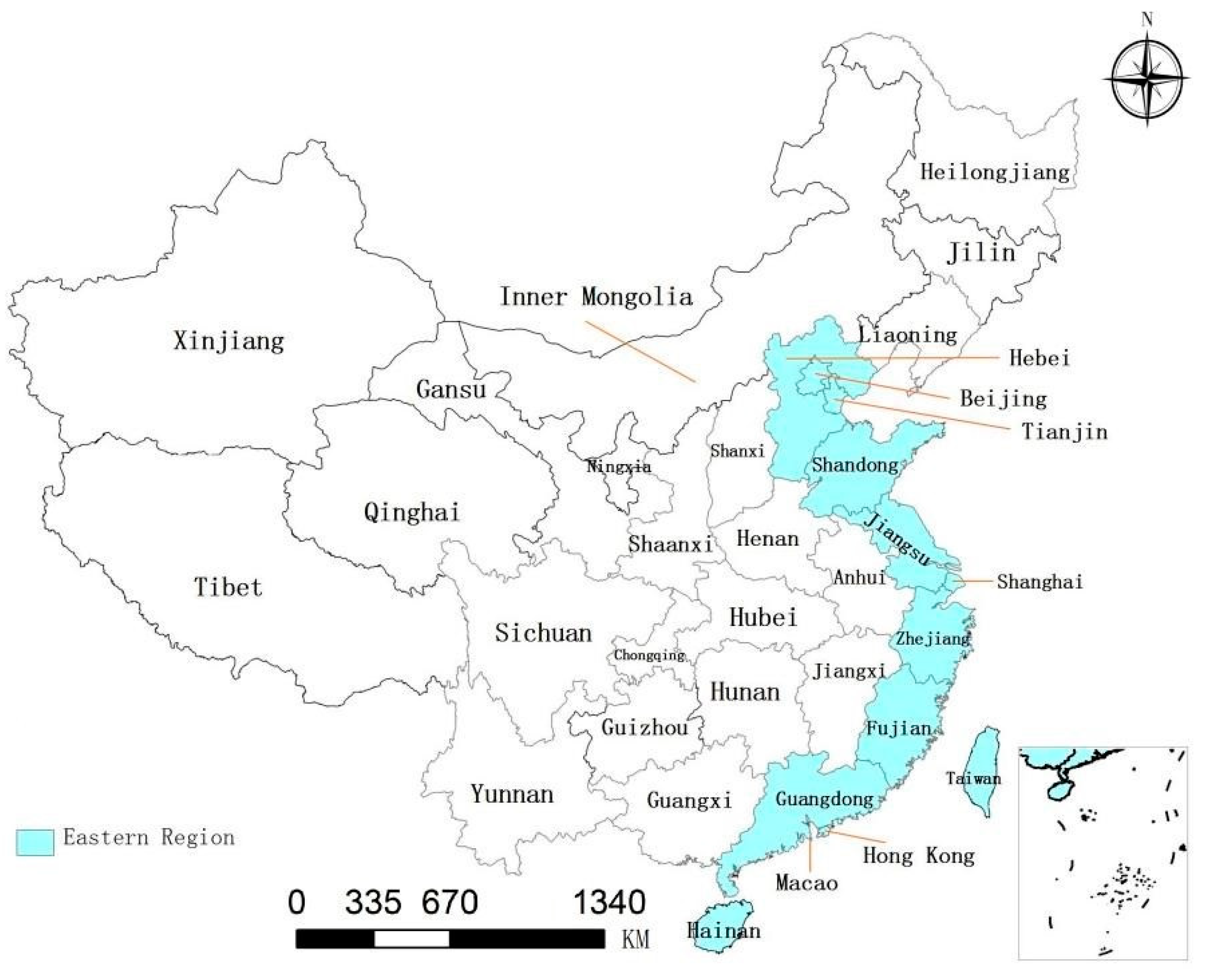
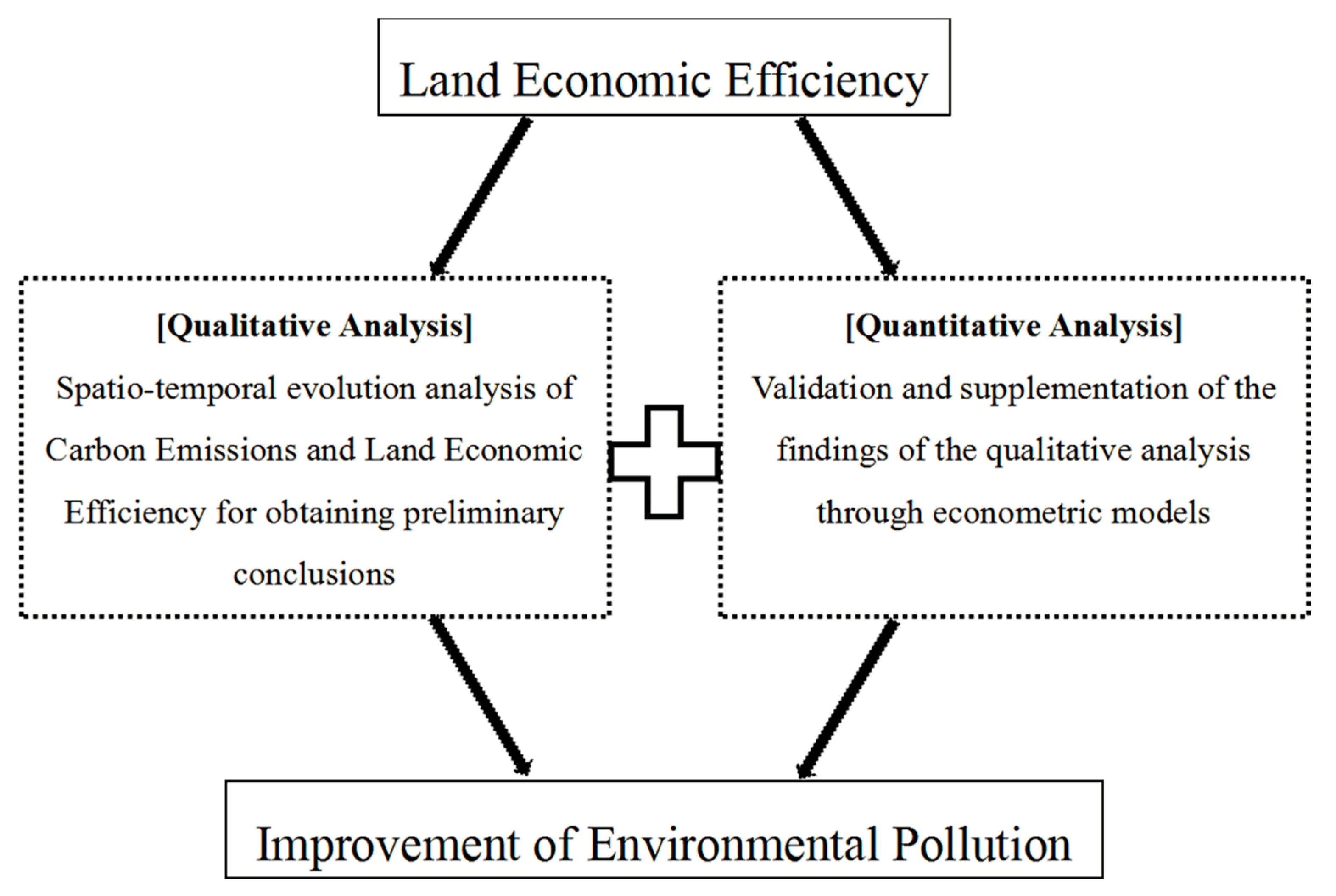
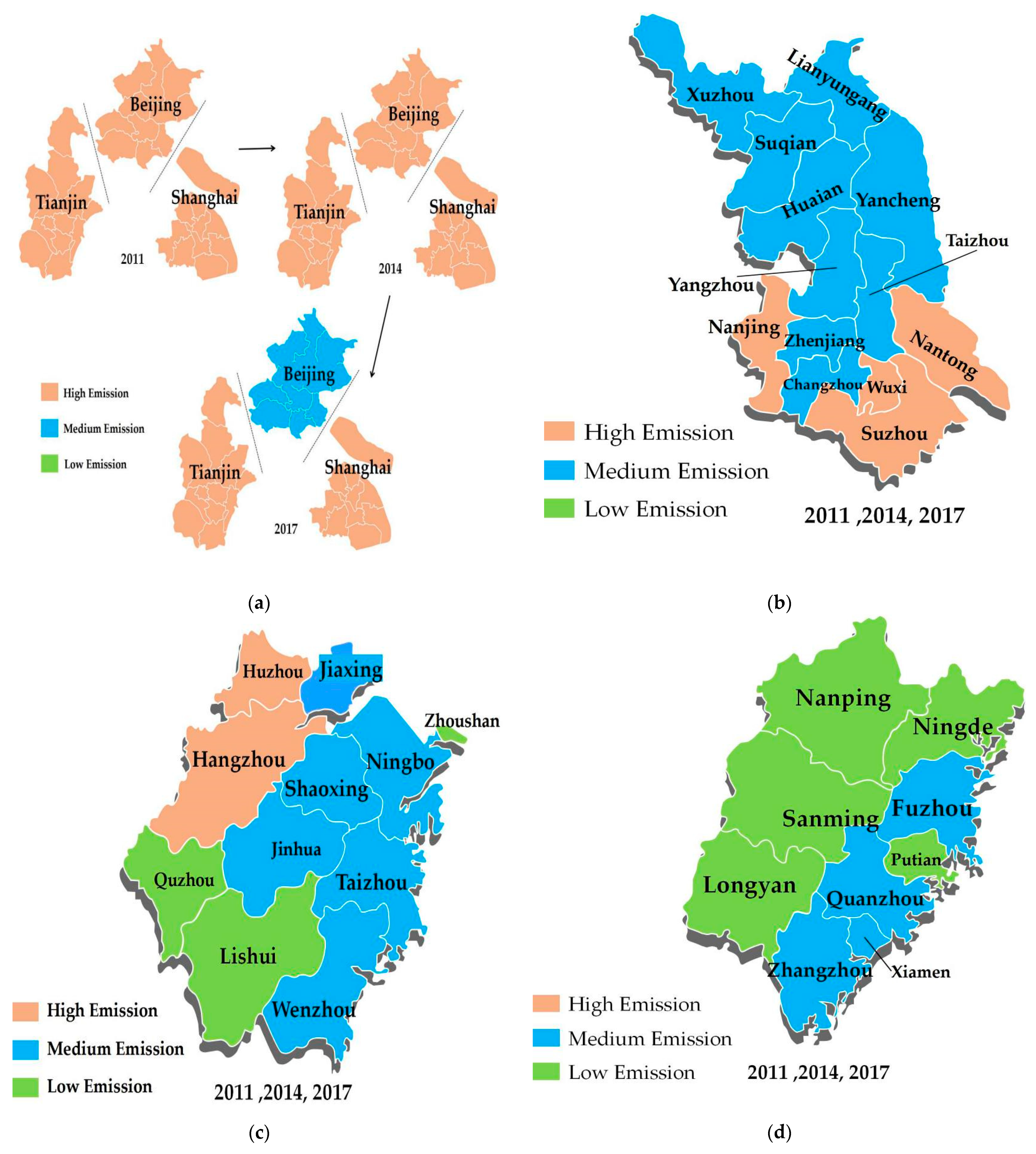

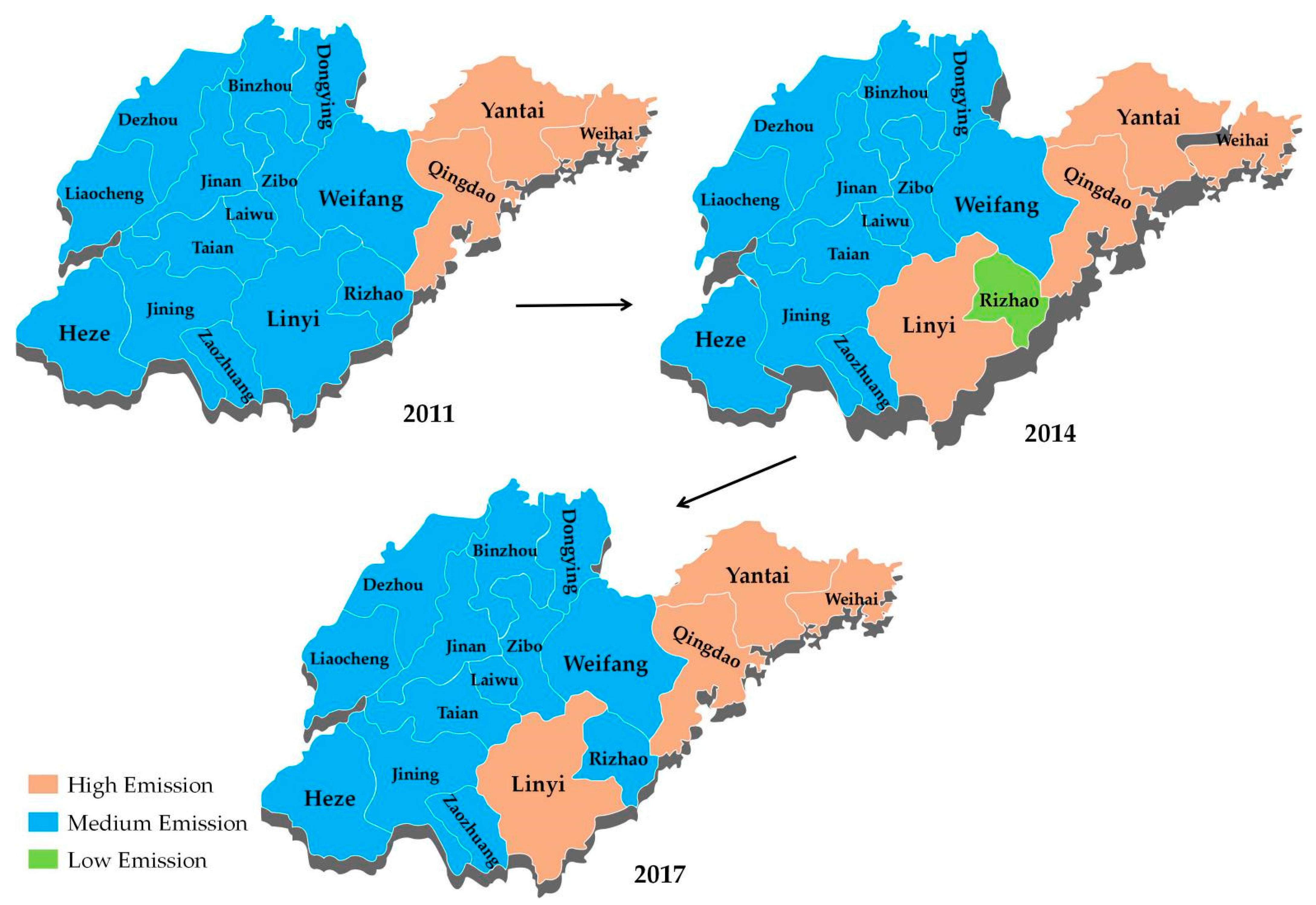
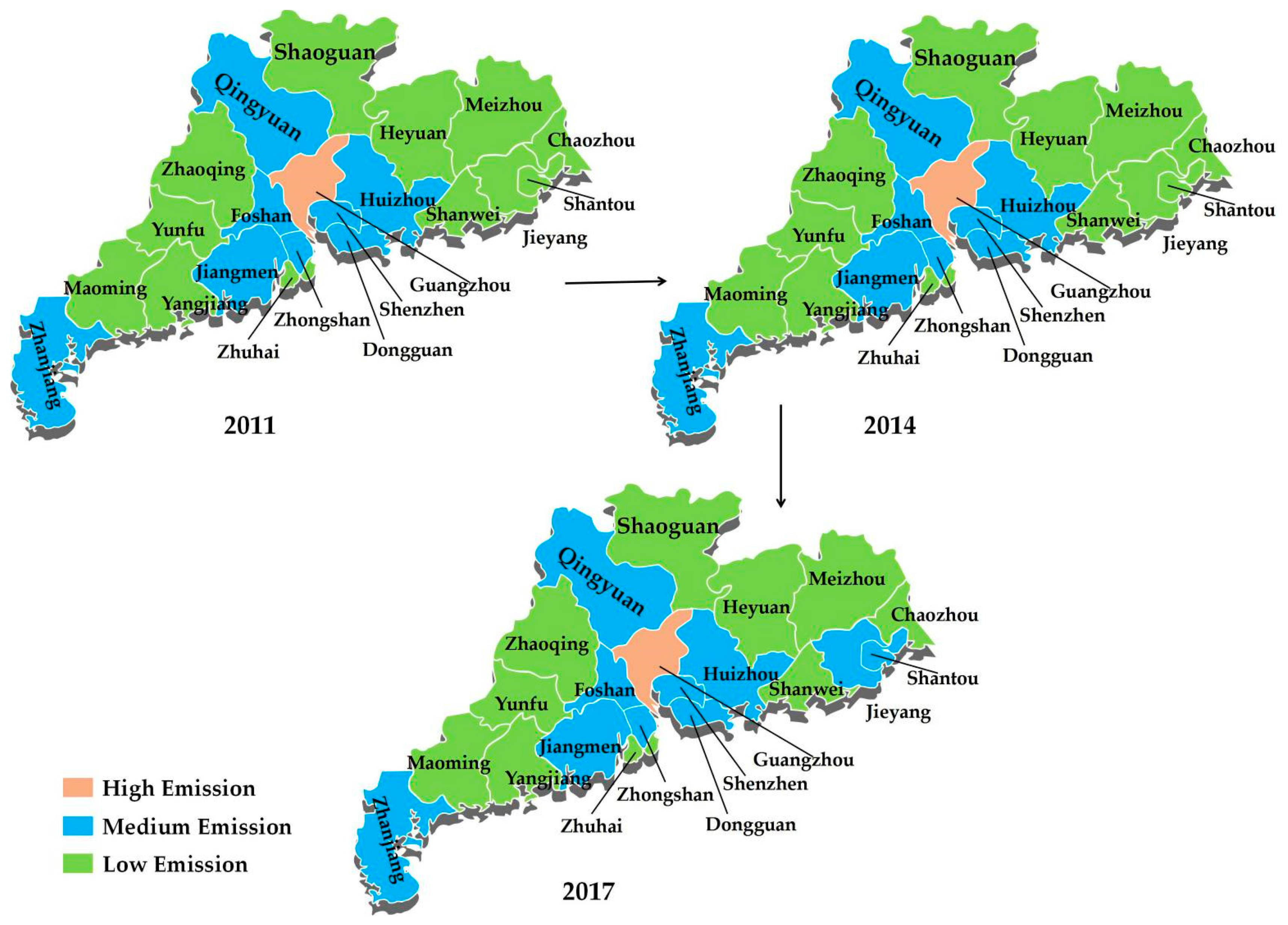
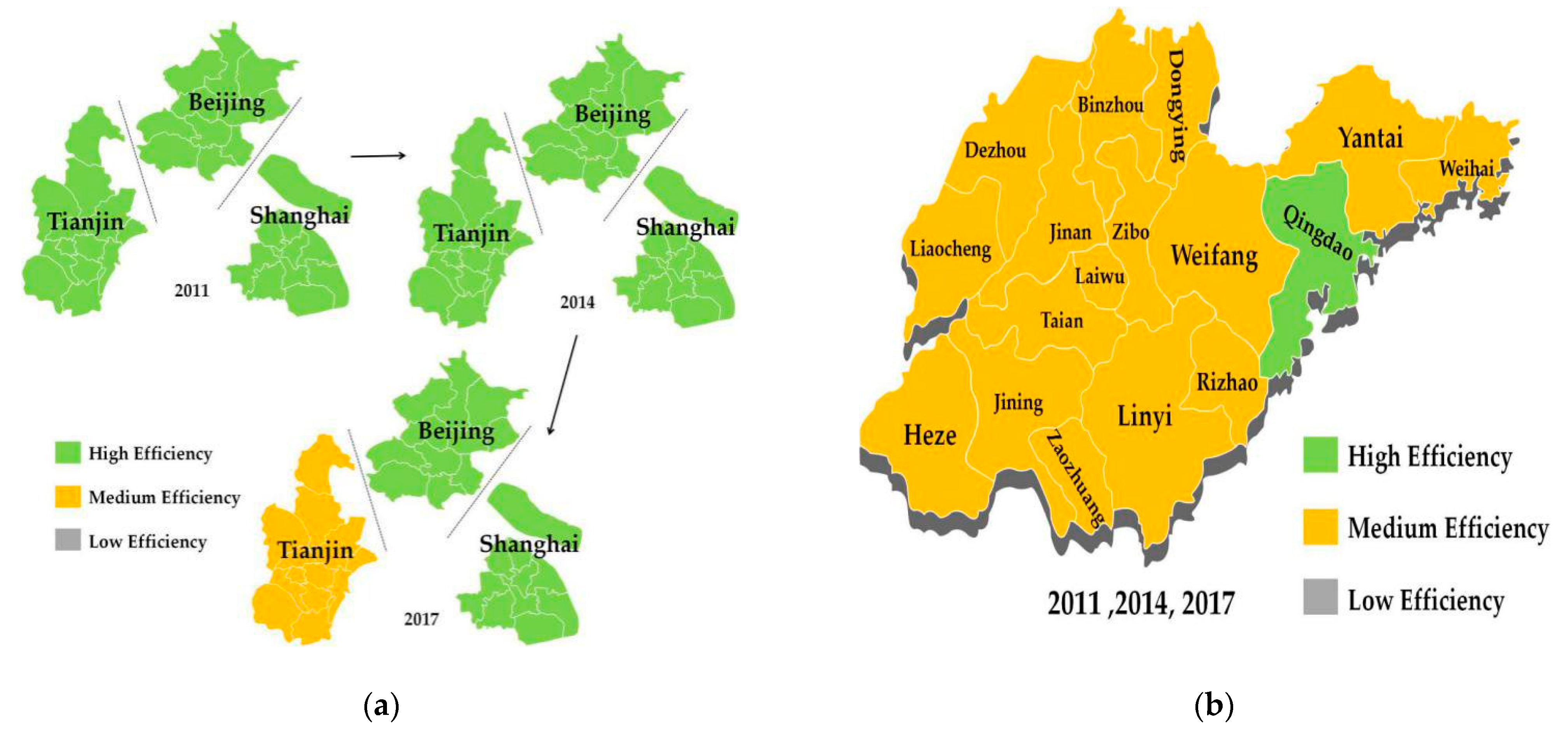
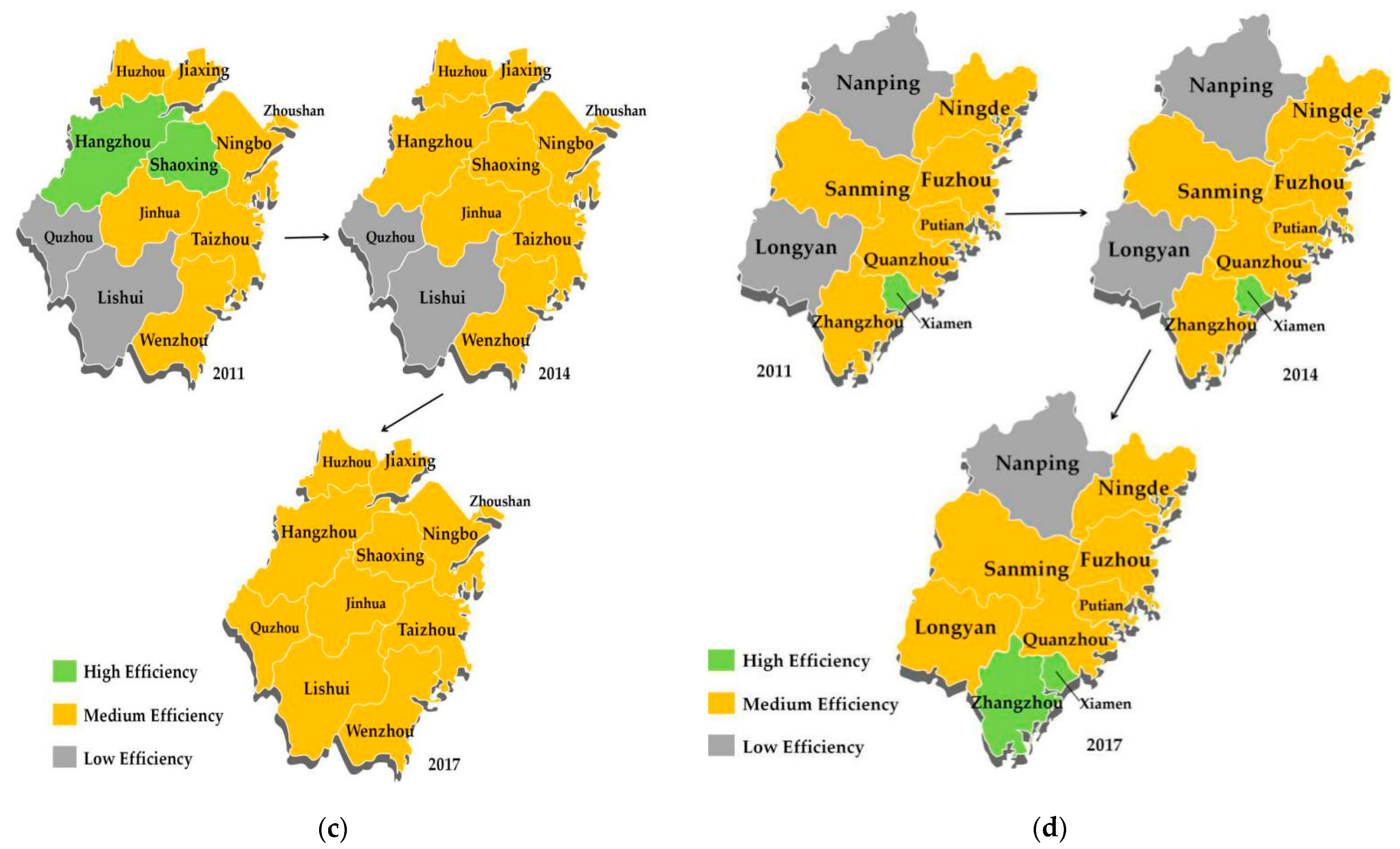
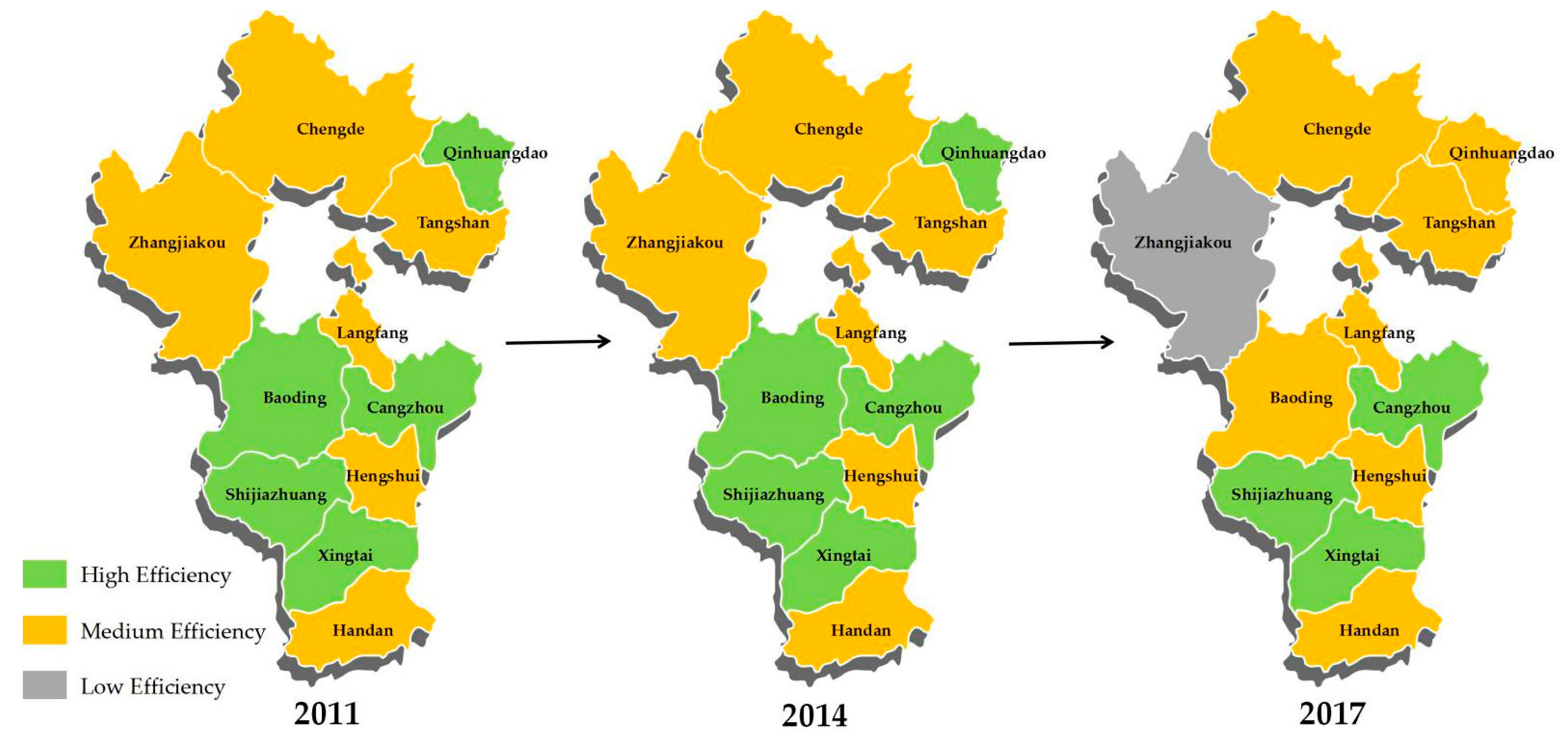
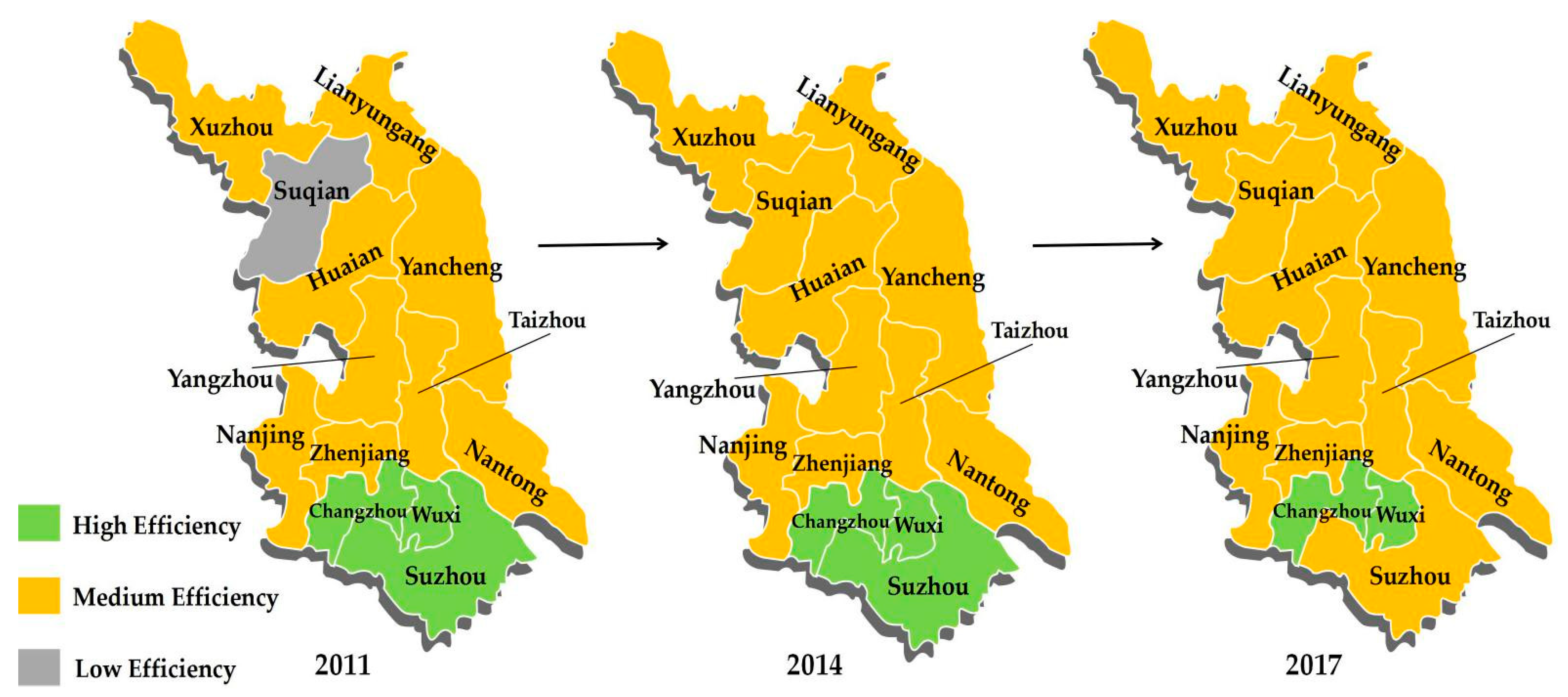
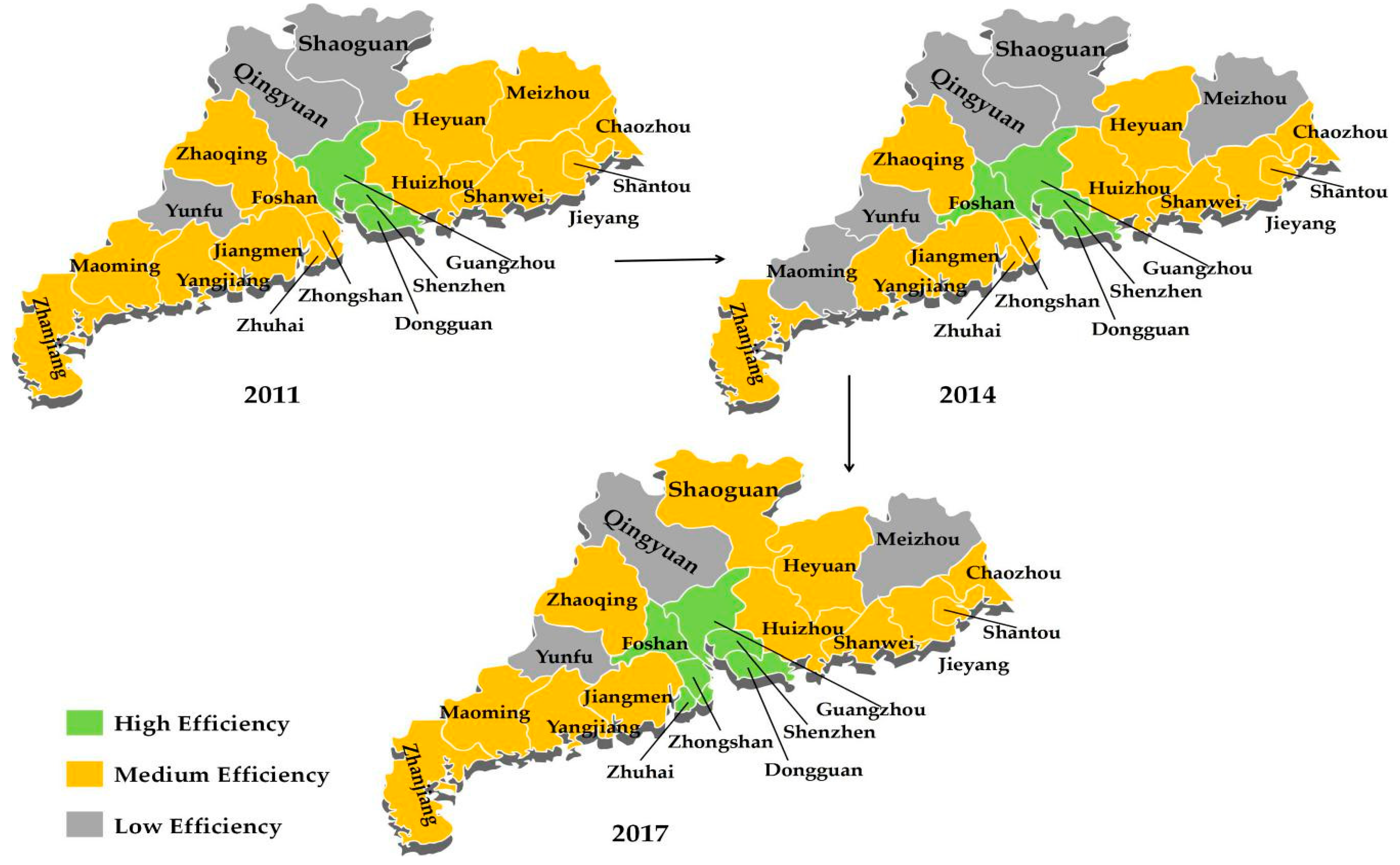
| Core Explanatory Variable | Dimension | Indicator | Unit | Average Weight (2011–2017) | Impact Ranking |
|---|---|---|---|---|---|
| Land economic efficiency (Land_EcoE) | Economic growth | GDP growth rate | % | 4.38% | 7 |
| Industrial production intensity | RMB 10,000/km2 | 22.62% | 2 | ||
| Economic structure | Share of tertiary output | % | 3.87% | 8 | |
| Tertiary industrial production intensity | RMB 10,000/km2 | 14.40% | 3 | ||
| Employment density | People/km2 | 12.71% | 4 | ||
| Economic quality | GDP per capita | RMB/people | 7.29% | 6 | |
| R&D intensity | RMB 10,000/km2 | 24.41% | 1 | ||
| Road density | % | 10.32% | 5 |
| Type | Variable | Unit | Obs | Mean | Std. | Min | Max | Label |
|---|---|---|---|---|---|---|---|---|
| Explained variable | Carbon emission | Million tons | 588 | 3.5417 | 0.6873 | 1.7576 | 5.4235 | Carbon |
| Explanatory variable | Land economic efficiency | - | 588 | 1.1905 | 1.4061 | 0.1079 | 13.8653 | Land_EcoE |
| Control variables | Foreign capital utilization intensity | USD million/km2 | 588 | 2.8392 | 1.6474 | −4.8793 | 5.9149 | Fore_CUI |
| Innovation intensity | Items/10,000 people | 588 | 4.8430 | 0.8303 | 2.4417 | 6.8811 | Inno_I |
| Explanatory Variables | I | II | III |
|---|---|---|---|
| Land_EcoE | 0.0006 | −0.0008 | −0.0003 |
| Control | YES | YES | YES |
| Time fixed effects | YES | - | YES |
| Spatial fixed effects | - | YES | YES |
| R-sq | 0.3709 | 0.0411 | 0.2120 |
| Obs | 588 | 588 | 588 |
| A-group | I | II | III |
|---|---|---|---|
| Explanatory Variables | |||
| Land_EcoE | 0.0130 ** | 0.0121 ** | 0.0127 *** |
| D_A * Land_EcoE | −0.0239 *** | −0.0249 *** | −0.0252 *** |
| Control | YES | YES | YES |
| Time fixed effects | YES | - | YES |
| Spatial fixed effects | - | YES | YES |
| R-sq | 0.2319 | 0.0622 | 0.2333 |
| Obs (A-group) | 56 | 56 | 56 |
| Obs | 588 | 588 | 588 |
| B-group | I | II | III |
| Explanatory Variables | |||
| Land_EcoE | 0.0133 ** | 0.0132 ** | 0.0138 *** |
| D_B * Land_EcoE | −0.0229 *** | −0.0251 *** | −0.0252 *** |
| Control | YES | YES | YES |
| Time fixed effects | YES | - | YES |
| Spatial fixed effects | - | YES | YES |
| R-sq | 0.2709 | 0.0627 | 0.2332 |
| Obs (B-group) | 126 | 126 | 126 |
| Obs | 588 | 588 | 588 |
Publisher’s Note: MDPI stays neutral with regard to jurisdictional claims in published maps and institutional affiliations. |
© 2021 by the authors. Licensee MDPI, Basel, Switzerland. This article is an open access article distributed under the terms and conditions of the Creative Commons Attribution (CC BY) license (https://creativecommons.org/licenses/by/4.0/).
Share and Cite
Chang, B.; Chen, L. Land Economic Efficiency and Improvement of Environmental Pollution in the Process of Sustainable Urbanization: Case of Eastern China. Land 2021, 10, 845. https://doi.org/10.3390/land10080845
Chang B, Chen L. Land Economic Efficiency and Improvement of Environmental Pollution in the Process of Sustainable Urbanization: Case of Eastern China. Land. 2021; 10(8):845. https://doi.org/10.3390/land10080845
Chicago/Turabian StyleChang, Binbin, and Lei Chen. 2021. "Land Economic Efficiency and Improvement of Environmental Pollution in the Process of Sustainable Urbanization: Case of Eastern China" Land 10, no. 8: 845. https://doi.org/10.3390/land10080845
APA StyleChang, B., & Chen, L. (2021). Land Economic Efficiency and Improvement of Environmental Pollution in the Process of Sustainable Urbanization: Case of Eastern China. Land, 10(8), 845. https://doi.org/10.3390/land10080845






